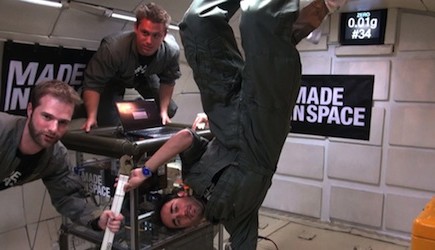First Space-based 3D Printer Open To Earthlings' Designs
September 26, 2013
on
on

Made In Space is the first company to launch a 3D printer into space in 2014. CSO Mike Chen invites the Maker community to submit printable ideas for extraterrestrial manufacturing.
21th century space exploration will be radically different from the modus operandi inherited from the space age. Instead of building things on Earth and shooting them into space, they will be manufactured off-planet. At least that's what Chen's colleague and co-founder of Made In Space Jason Dunn convincingly argued at a TEDx conference [embedded below].
Space-based production will reduce the cost of space exploration. Launch costs make up a significant part of a space mission’s budget. The cheapest option is the transportation service of SpaceX. The company delivers a 13,150 kg payload into Low Earth Orbit for $56 million.
Another advantage is that the payload does not need to endure the brutal forces it encounters on its journey through the atmosphere. Rather than building space technology designed to survive the launch engineers could focus on optimization for its existence in microgravity.
Made In Space is now developing the first additive manufacturing unit for space. The company is contracted by NASA to deliver a 3D printer to the International Space Station in the summer of 2014. When it arrives it will be the first time astronauts can produce their own items rather than being utterly dependent on deliveries from Earth. The most critical application is the ability to create spare parts when needed but it will also be used for more frivolous things that didn't make it onto the meticulously curated ISS packing list.
Although Chen and Dunn hope to outsource manufacturing to the rest of the solar system, the best place for good ideas is still the blue planet. At the World Maker Faire in New York Chen invited the attendees to pool their creativity and come up with original must-haves for outer space. "Once our printer is there, we're going to be opening it up to the world to print things in space", said Chen according to a report of Space.com. Ideas can be submitted through the contact page of Made In Space.
Via: Space.com
Image: Made in Space
21th century space exploration will be radically different from the modus operandi inherited from the space age. Instead of building things on Earth and shooting them into space, they will be manufactured off-planet. At least that's what Chen's colleague and co-founder of Made In Space Jason Dunn convincingly argued at a TEDx conference [embedded below].
Space-based production will reduce the cost of space exploration. Launch costs make up a significant part of a space mission’s budget. The cheapest option is the transportation service of SpaceX. The company delivers a 13,150 kg payload into Low Earth Orbit for $56 million.
Another advantage is that the payload does not need to endure the brutal forces it encounters on its journey through the atmosphere. Rather than building space technology designed to survive the launch engineers could focus on optimization for its existence in microgravity.
Made In Space is now developing the first additive manufacturing unit for space. The company is contracted by NASA to deliver a 3D printer to the International Space Station in the summer of 2014. When it arrives it will be the first time astronauts can produce their own items rather than being utterly dependent on deliveries from Earth. The most critical application is the ability to create spare parts when needed but it will also be used for more frivolous things that didn't make it onto the meticulously curated ISS packing list.
Although Chen and Dunn hope to outsource manufacturing to the rest of the solar system, the best place for good ideas is still the blue planet. At the World Maker Faire in New York Chen invited the attendees to pool their creativity and come up with original must-haves for outer space. "Once our printer is there, we're going to be opening it up to the world to print things in space", said Chen according to a report of Space.com. Ideas can be submitted through the contact page of Made In Space.
Via: Space.com
Image: Made in Space
Read full article
Hide full article


Discussion (0 comments)